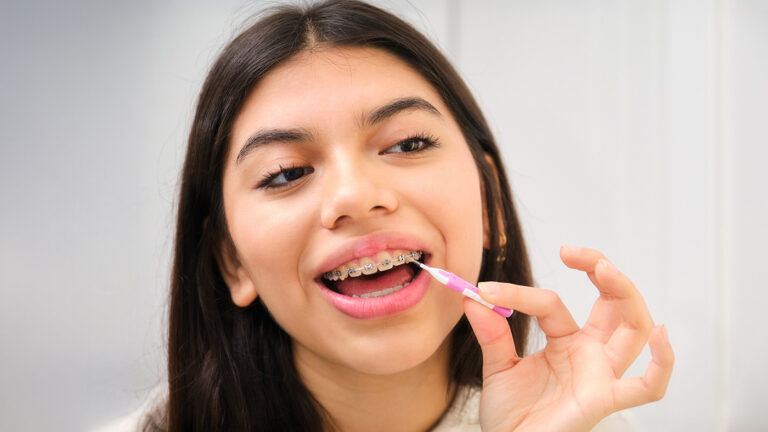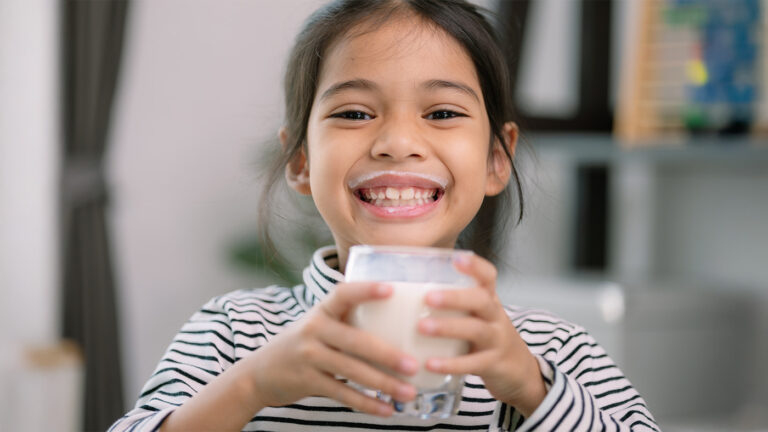Starting the journey to a straighter smile is an exciting moment in any kid’s (or adult’s) life, but braces will impact more than just your teeth. You’ll also have to make some minor and temporary lifestyle adjustments. One of the first questions patients ask before or immediately after starting treatment is how braces will affect their eating habits.
Braces are strong enough to slowly push your teeth into a more desired position, but fragile enough to break when faced with the wrong snack food. Braces work by attaching brackets and a wire together. Risky snack foods increase the risk of breaking a bracket or a wire, which can delay your treatment. Additionally, even if your braces don’t break, certain foods can get stuck in your braces, increasing the risk of cavities.
The good news is that you won’t have to give up your favorite meals and snack foods forever, but you may need to avoid certain foods temporarily during your orthodontic treatment. As an upside, braces are a great opportunity to try out new foods. You might even discover a new favorite snack you wouldn’t otherwise have tried. If you’re curious what foods are safe for braces and which ones aren’t, we’ve got you covered with some suggestions and guidelines.
What Can’t You Eat With Braces
Good dental hygiene begins with what you put in your mouth. With a bit of caution, braces won’t prevent you from eating most of your favorite foods, but you may have to make some adjustments to your snacking habits. Avoiding certain foods will also help prevent damage to brackets and wires, ensuring that your orthodontic treatment continues uninterrupted. Avoid or be cautious with these common trouble foods.
- Chewy: Avoid dense and chewy breads, such as bagels or pizza crusts, which can damage brackets and get stuck in your teeth.
- Crunchy: Avoid snack foods like popcorn, granola, and chips. These foods are notorious for breaking brackets, not to mention irritating the gums.
- Sticky: Avoid sticky treats, such as caramel and gummy candies. These can put too much pressure on wires or brackets, stick to your braces and teeth, and increase the risk of cavities.
- Hard: Avoid hard foods like nuts, jerky, and hard candies, which can pop brackets loose, break wires, or put painful pressure on sensitive teeth and gums.
- Sugary: Excessively sugary foods increase the risk of cavities and gum disease, something which is already a concern during orthodontic treatment.
- Whole: Avoid tough foods you bite directly into. Foods like apples and corn on the cob run the risk of popping brackets loose. Instead, cut the corn off the cob and cut the apple up to make them easier to eat.
What Can You Eat With Braces
Maintaining a braces-safe diet is important throughout your orthodontic treatment, but especially in the beginning. The first few days after braces are placed or after an adjustment, your mouth will feel sensitive and achy. During these periods, sticking to soft foods like mashed potatoes, applesauce, and bananas can reduce pain associated with chewing.
Here are some ideas of foods you can eat with braces.
Soft Foods To Eat With Braces
- Oatmeal
- Scrambled eggs
- Soup or chili (you can pack them full of vegetables, protein, and flavor)
- Pasta
- Soft, cooked vegetables
- Mashed potatoes
- Fruits, such as bananas, melons, grapes, oranges, and other soft fruits, are great options. When eating hard fruits like apples, make sure to cut them into pieces instead of biting into them directly. Apple sauce is an even easier, nutrient-filled option.
- Peanut butter (smooth, not crunchy)
- Yogurt
- Ice cream
- Smoothies – you can make a million different kinds, from peanut butter and chocolate to fruit medleys and everything in between. Not only are smoothies easy on sensitive teeth, they’re also a great way to sneak some fruits and vegetables into your diet.
- Soft breads, avoid breads with hard or chewy crusts like pretzels or bagels
- Rice
- Soft proteins like chicken tofu, cooked beans, or fish. Use caution when eating tough or chewy cuts of meat, such as beef or pork. When in doubt, opt for something softer.
Over time, as you get used to wearing braces and the initial pain subsides, you can start adding foods back into your diet. No matter what you’re eating, these tips will help keep your braces in good working order.
Cut your food – Cut food into bite-sized pieces and place them in your mouth. This avoids biting directly into risky foods until you get accustomed to eating with braces.
Avoid extreme temperatures – While warm or cold foods don’t pose a direct risk to your braces, they can be uncomfortable on already sensitive teeth.
Chew carefully – Slow down and chew your food gently. A misplaced bite can not only damage your braces, but there’s also the risk of biting your lip or cheek while you’re getting used to your braces.
Brushing – Our goal is to have all patients brush 3 times a day for 2 minutes each time. Use of a Water Pik or similar product is a great way to get food particles off the gums and teeth that tooth brushing alone can’t get.
Swish and rinse – Rinse with water after meals or snacks. This helps to dislodge particles trapped between your teeth or in your braces. Rinsing with a fluoride mouthwash has the added benefit of protecting your teeth against cavities and tooth decay.
Drink water – In addition to helping you stay hydrated, every swallow of water rinses your teeth and mouth, reducing the risk of cavities.
Show up – Schedule and keep all of your dental and orthodontic appointments to make sure your treatment continues as smoothly as possible. If you do have any issues, your dentist and orthodontist will be able to address them early. Appointments are the perfect time to ask any questions as you complete your journey to your perfect smile.
SOURCES:
American Association of Orthodontists
Colgate
Molen Orthodontics




